In this review, we will try to make a connection between evolutionary hypotheses, the influence of hormones and gender differences in the structure of the genome, as well as consider historical examples of the methods of “biohacking” of the aging mechanism in men, which you definitely would not want to use.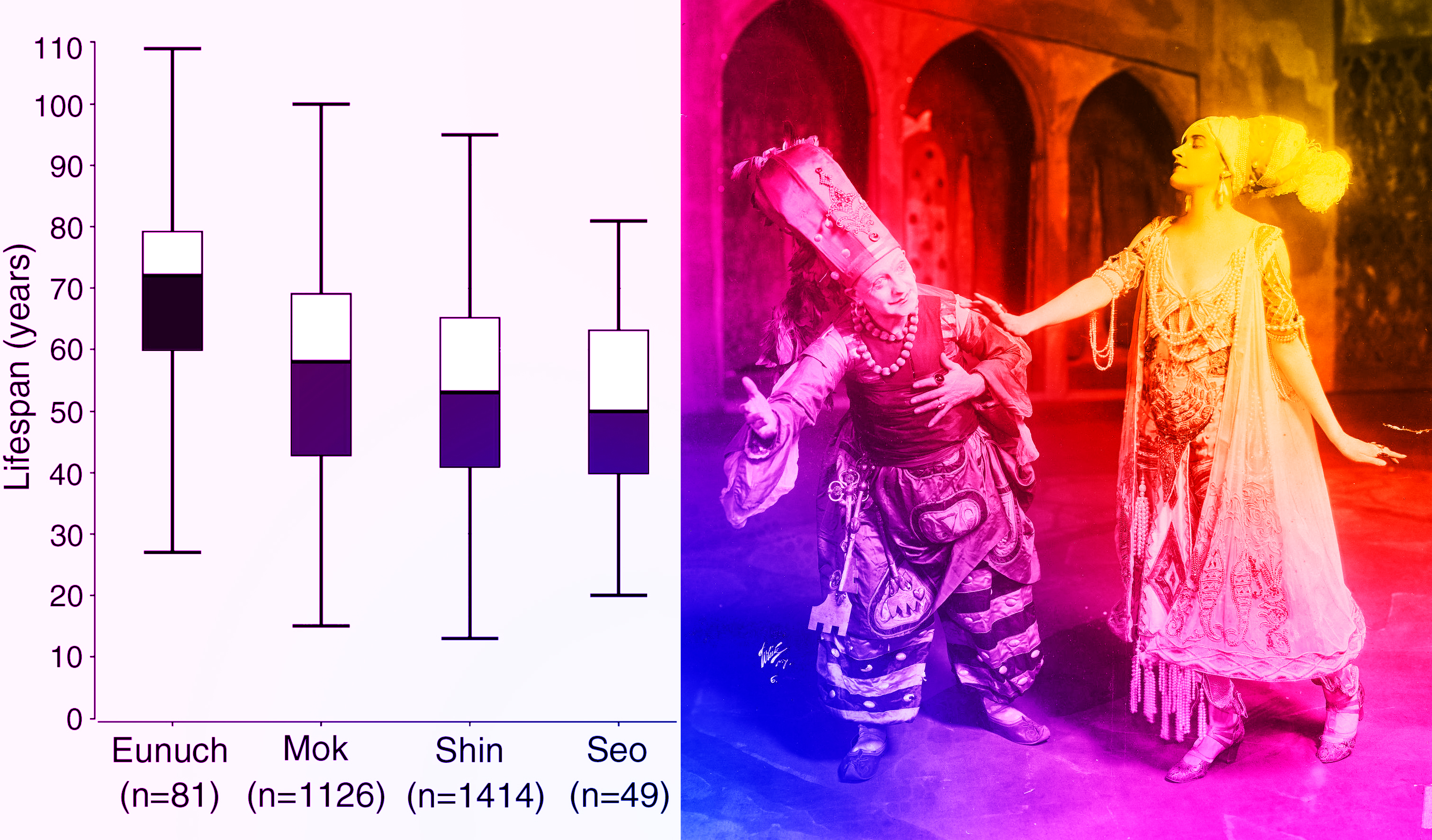
Content:
- Weaker sex
- Hypothesis of discrimination
- The paradox of mortality-morbidity
- Post-reproductive life span
- "Unprotected - X" hypothesis
- Discussion
Weaker sex
The vast majority of animal species have two sexes, and often the life expectancy between the sexes varies greatly, on average, the spread is about 20% [ 1 ], but in some cases it can reach up to 100% [ 2 ]. However, in most cases, there is an advantage in the longevity of females.Data on gender inequality in life expectancy in people show a similar picture; on average, women die about 5 years later than men in the world. Although there is a wide spread across countries, undoubtedly related to cultural and social factors (Russia can be a sad example, men here die an average of 11.5 years earlier than women), but if you look at the distribution of the relative difference between the life expectancy of men and women by countries, you can see that:- the gap between men and women almost does not correlate with overall life expectancy
- most likely it does not correlate well with any cultural traditions, since for the most part of the distribution, countries with very different cultural traditions and living standards often appear nearby, for example, such as: Jamaica - Belgium or Togo (western Africa) and Sweden
 The green bar is the total life expectancy, the blue bar is the fraction of the total life expectancy, which is the difference between the life expectancy of women and men in each country. Data source [ 3 ]From all this, we can assume that there are some universal factors that are independent of cultural and social conditions that also affect the gender gap in the life expectancy of men and women.
The green bar is the total life expectancy, the blue bar is the fraction of the total life expectancy, which is the difference between the life expectancy of women and men in each country. Data source [ 3 ]From all this, we can assume that there are some universal factors that are independent of cultural and social conditions that also affect the gender gap in the life expectancy of men and women.Hypothesis of discrimination
We propose to consider the main groups of hypotheses explaining this apparent discrimination on the basis of sex, and also try to draw a logical connection between them.Evolutionary hypotheses suggest that the difference in life expectancy is related to sexual selection. If we evaluate the success of the animal as the number of offspring to which the individual passed its genes, then the males can benefit by choosing the “live fast - die young” strategy. By maximizing the number of mating, they have to spend their resources on maintaining secondary sexual characteristics such as bright coloring and large horns, as well as fighting for females in tournaments, demonstrating physical superiority. All this is accompanied by high costs for male organisms and carries life risks, but also allows you to select the most adapted genes for the population. A pair of ducks tangerines, male on the left, female on the right. Source: en.wikipedia.org/wiki/Sexual_dimorphism#/media/File: Pair_of_mandarin_ducks.jpgOn the other hand, the female gender, as a rule, makes a much greater contribution to development and cannot get the same reproductive benefit from an increase in the number of mating per unit of time, therefore it relies on the strategy : “If you drive more slowly , you will continue.” Based on this, the reproductive success of females of most species is more dependent on life expectancy than males, from which it can be assumed that selection will be more likely to fix characters that contribute to the longevity of females [ 4 ].
A pair of ducks tangerines, male on the left, female on the right. Source: en.wikipedia.org/wiki/Sexual_dimorphism#/media/File: Pair_of_mandarin_ducks.jpgOn the other hand, the female gender, as a rule, makes a much greater contribution to development and cannot get the same reproductive benefit from an increase in the number of mating per unit of time, therefore it relies on the strategy : “If you drive more slowly , you will continue.” Based on this, the reproductive success of females of most species is more dependent on life expectancy than males, from which it can be assumed that selection will be more likely to fix characters that contribute to the longevity of females [ 4 ].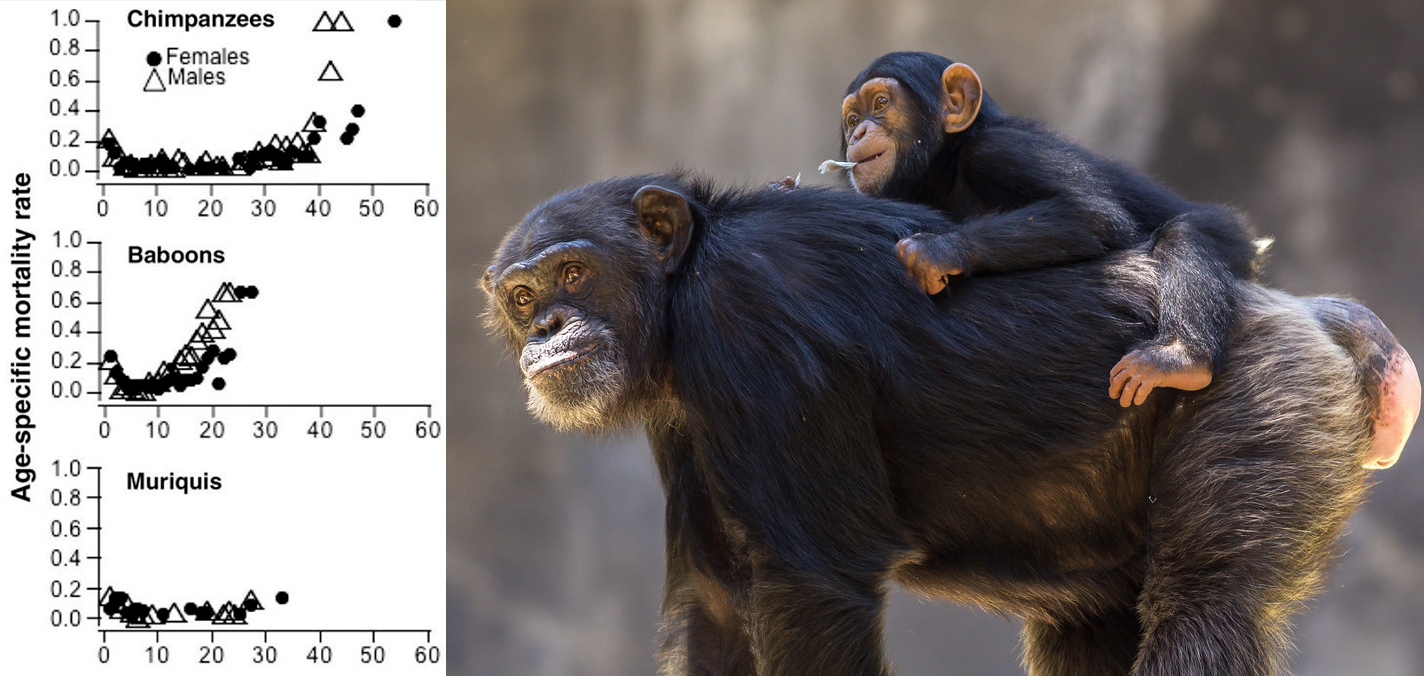 On the left are graphs of differences in mortality between the sexes of different species of primates. To the right is a female chimpanzee with a cub. Chart Source: www.ncbi.nlm.nih.gov/pmc/articles/PMC3396421/#R15
On the left are graphs of differences in mortality between the sexes of different species of primates. To the right is a female chimpanzee with a cub. Chart Source: www.ncbi.nlm.nih.gov/pmc/articles/PMC3396421/#R15
Image Source:www.flickr.com/photos/7654576@N02/14653025323At the same time, since the longevity of the males is not under such severe pressure of selection, they can fix genes that give advantages in reproduction and tournaments for females, but at the same time negatively generally affecting life expectancy. And candidates for such pleiotropic genes may be genes for the sex hormones of males.In support of this idea, one can cite the results of a study in birds, which showed the inverse relationship between the level of sex hormone - testosterone (responsible for the formation of secondary sexual characteristics) and the level of the immune response, as well as resistance to oxidative stress.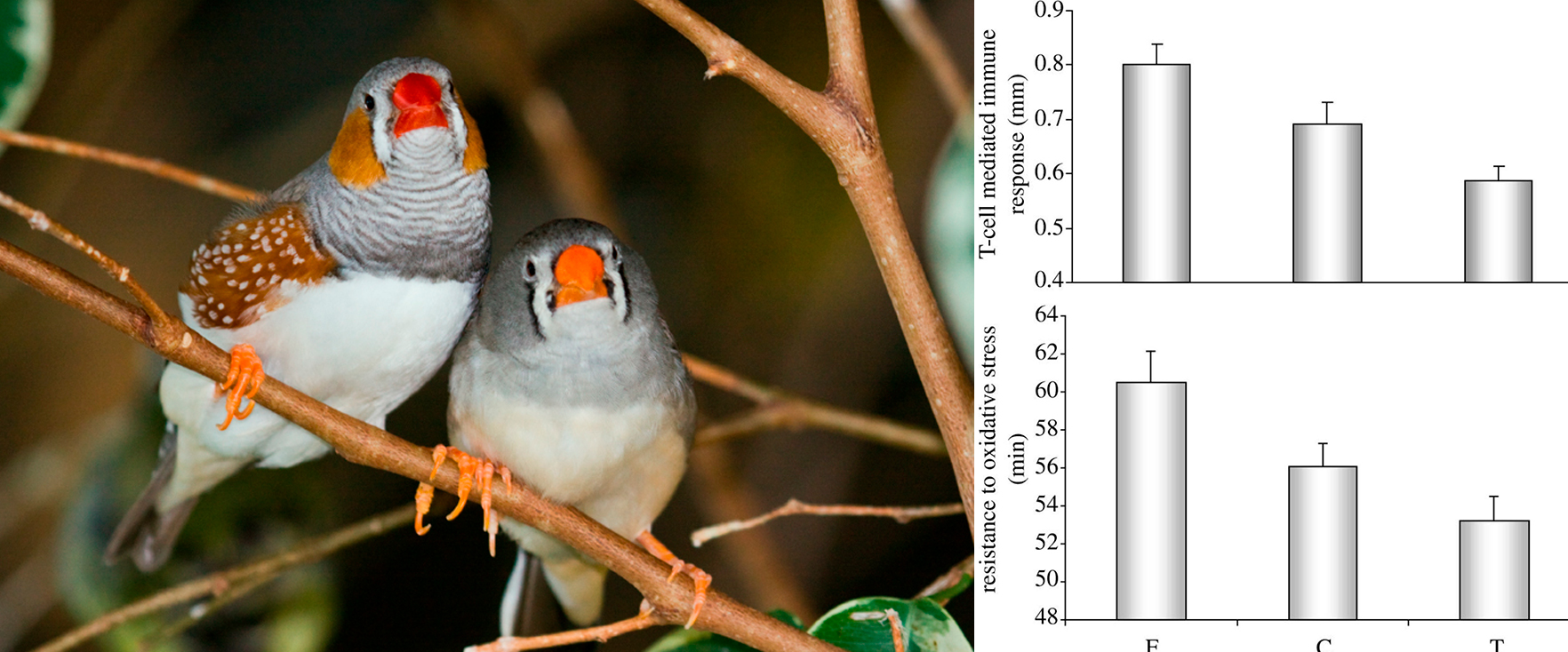 Left: a pair of zebra amadins (male on the left), sourcetop right: the level of the immune response depending on the level of testosterone; bottom right: the resistance to oxidative stress depending on the level of testosterone source [ 5 ].For four weeks, 42 zebra amadins, small finch family birds, had implants placed under their skin, depending on the group, either testosterone or phthalamide (an androgen receptor antagonist that triggers a cell response to testosterone), the control group received an empty the implant [ 5 ].Additional evidence in support of the hypothesis of the “dark side” of reproductive success can also be observational retrospective data on the life expectancy of eunuchs - people who have a lifetime lack of testosterone as a result of castration. Researchers studied, according to genealogical records, the life expectancy of 81 eunuchs who lived in Korea in the 18-19th centuries and compared with the life expectancy of men of that period who were not castrated. Comparing the data, the scientists considered that, on average, eunuchs lived 15-20 years longer [ 6 ]
Left: a pair of zebra amadins (male on the left), sourcetop right: the level of the immune response depending on the level of testosterone; bottom right: the resistance to oxidative stress depending on the level of testosterone source [ 5 ].For four weeks, 42 zebra amadins, small finch family birds, had implants placed under their skin, depending on the group, either testosterone or phthalamide (an androgen receptor antagonist that triggers a cell response to testosterone), the control group received an empty the implant [ 5 ].Additional evidence in support of the hypothesis of the “dark side” of reproductive success can also be observational retrospective data on the life expectancy of eunuchs - people who have a lifetime lack of testosterone as a result of castration. Researchers studied, according to genealogical records, the life expectancy of 81 eunuchs who lived in Korea in the 18-19th centuries and compared with the life expectancy of men of that period who were not castrated. Comparing the data, the scientists considered that, on average, eunuchs lived 15-20 years longer [ 6 ]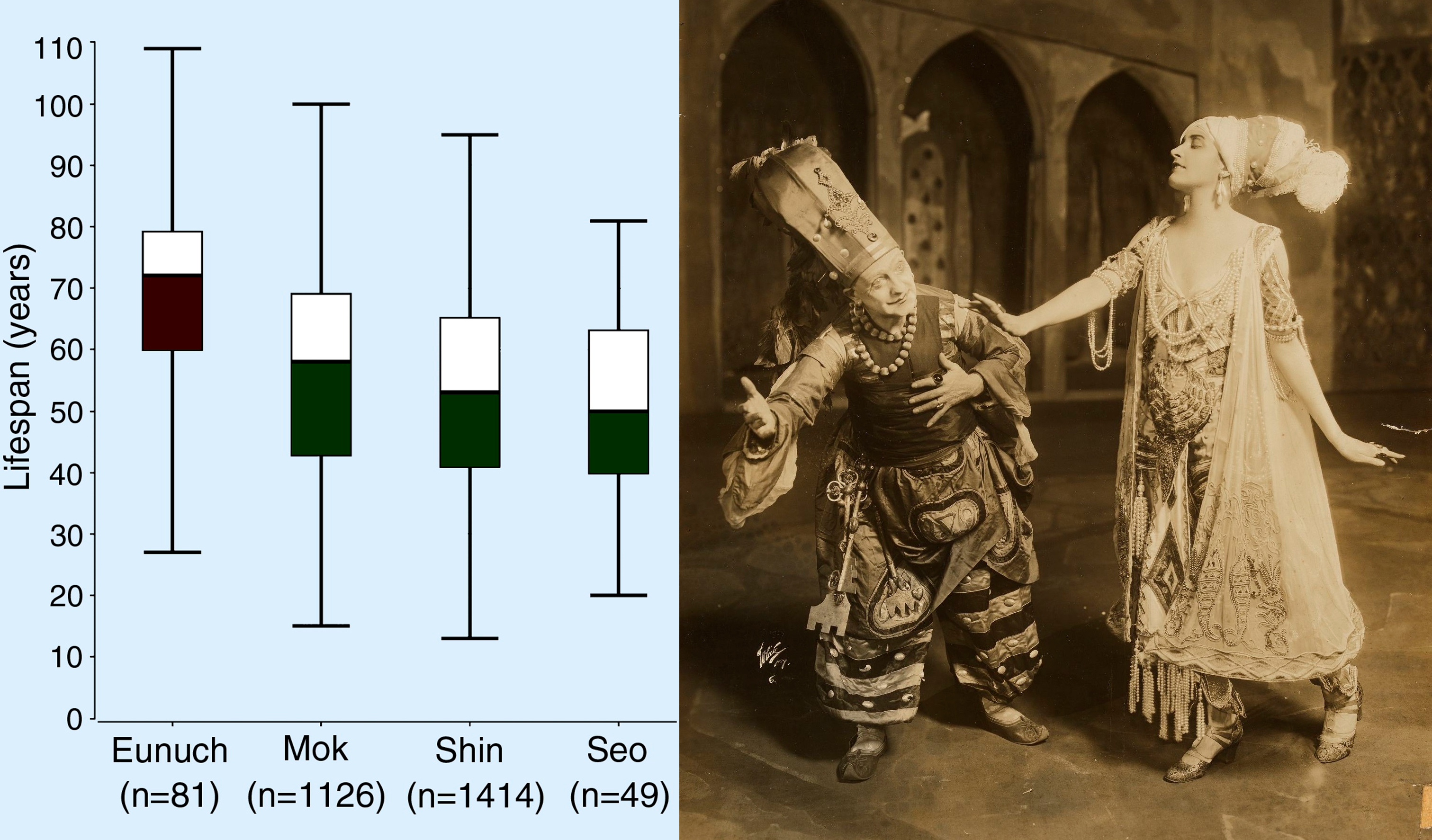 On the left are the results of the analysis of data from genealogical records on the life expectancy of various classes in Korea in the 18-19th centuries source [ 6 ]
On the left are the results of the analysis of data from genealogical records on the life expectancy of various classes in Korea in the 18-19th centuries source [ 6 ]
On the right, the acting duo Enrico Cecchetti and Flor Revales as Eunuch and Zabeida in the production of Scheherazade, the source
On the other hand, the main female sex hormone, estrogen, on the contrary, helps to reduce inflammation, due to the fact that it reduces the time spent by macrophages on inflammatory status [ 7 ]. Many effects of estrogen's positive effects on longevity and a lower risk of cardiovascular disease have been described [ 8 ], and it has also been shown that treatment of cell cultures with estrogen, in vitro, reduced the level of cell death caused by oxidative stress [ 9 ].The paradox of mortality-morbidity
The pleiotropic (multiple) effect of sex hormones described above can provide a clue to the explanation of the so-called paradox of mortality-morbidity. The observed effect is that women, although they live longer than men, but at a later age suffer more from various diseases, often go to doctors and evaluate their health worse than men of the corresponding age [ 10 ].So if you look at mortality among men and women in 4 countries of Europe (Denmark, Norway, Sweden, Finland) for the period 1950-2005, and divide the data into 5 age groups, you can see that the difference between men and women reaches its maximums in the reproductive period, when the effect of sex hormones is most pronounced and almost leveled by the age of 65-84 years [11 ]. The difference in mortality among men and women in different age groups, in Denmark, Norway, Sweden and Finland for the period 1950-2005. Source [ 11 ]The assumption that the men who survived during the period of the negative effects of testosterone were “selected” organically fit into these data and only the most healthy and stable individuals survive until the level of sex hormones decreases, while women, on the contrary, the onset of menopause loses estrogen protection against inflammatory reactions and oxidative stress and begins to feel generally worse.
The difference in mortality among men and women in different age groups, in Denmark, Norway, Sweden and Finland for the period 1950-2005. Source [ 11 ]The assumption that the men who survived during the period of the negative effects of testosterone were “selected” organically fit into these data and only the most healthy and stable individuals survive until the level of sex hormones decreases, while women, on the contrary, the onset of menopause loses estrogen protection against inflammatory reactions and oxidative stress and begins to feel generally worse.Post-reproductive life span
An interesting question regarding the explanation of the mortality-morbidity paradox is why so far it has been observed only in people? [ 12 ] To understand this, it is worth paying attention to the post-reproductive life expectancy among women and females of other species.A study published in January 2018 in the journal Ecology and evolution summarizes data on the life expectancy of 52 species of placental mammals, measuring the ratio of female life years before and after the end of the reproductive period. The distribution turned out to be really unexpected; three species were leading by a wide margin: humans, killer whales and short-fin grind (a mammal from the dolphin family). The share of post-reproductive years of life in all three species amounted to more than a quarter of the total years of life, while in all the rest it did not differ much from zero.When the female reached the age of the last breeding, her life expectancy was for humans = 26 years, killer whales = 29 years and short-fin grind = 13 years [ 13 ].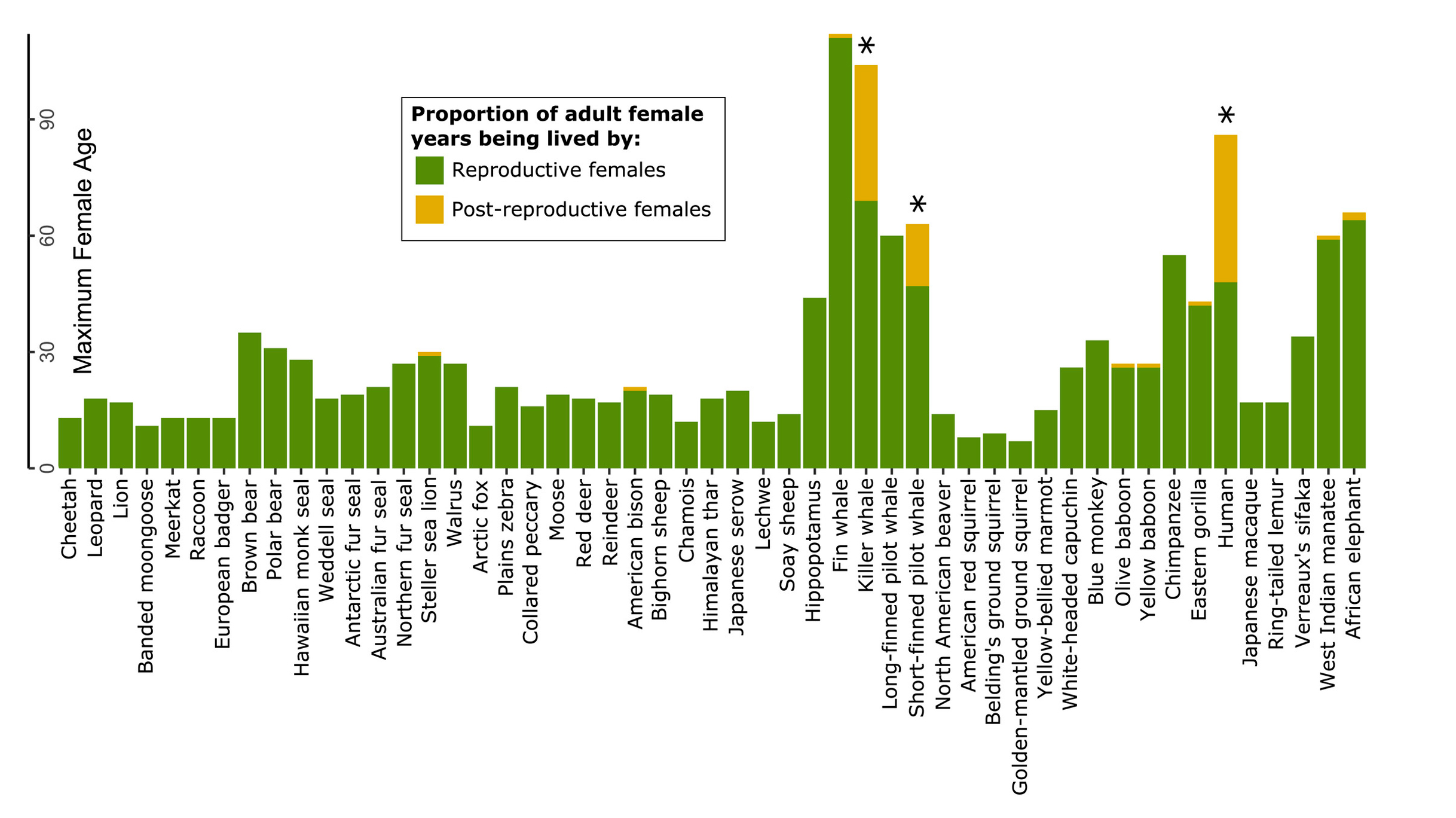 The height of the columns of the diagram is the maximum life expectancy of females of different species, the yellow part of the columns is the proportion of post-reproductive life expectancy. Source [ 13 ]It is curious that the short-finned grind is just the champion in the difference in life expectancy between the sexes, mentioned at the very beginning of the article, their females live almost twice as long as the males. [ 2 ]
The height of the columns of the diagram is the maximum life expectancy of females of different species, the yellow part of the columns is the proportion of post-reproductive life expectancy. Source [ 13 ]It is curious that the short-finned grind is just the champion in the difference in life expectancy between the sexes, mentioned at the very beginning of the article, their females live almost twice as long as the males. [ 2 ] The appearance of the animal is a fin-finned grind. Source www.fisheries.noaa.gov/species/short-finned-pilot-whale
The appearance of the animal is a fin-finned grind. Source www.fisheries.noaa.gov/species/short-finned-pilot-whale"Unprotected - X" hypothesis
Another piece of the puzzle that complements the explanation of the effect of sexual dimorphism in life expectancy and explains why, despite all the above arguments, males still live longer than females in some species, the hypothesis of an unprotected heterogametic sex chromosome may become. [ 14 ]Most animal species on Earth have two sexes and a double (diploid) set of chromosomes, and since each chromosome is duplicated, this provides “insurance” in case of damage to one copy. As a rule, gender differences at the level of genome architecture are that representatives of the same gender, in a certain pair of chromosomes, do not have copies, but two different chromosomes, this gender is called heterogametic.So in humans the heterogametic sex is male, and the presence of two sex chromosomes XX is a sign of homogametic sex - female. The harm from information damage in the X chromosome in women can be smoothed out due to the presence of a second copy, in men it can be said that the X chromosome is not protected, which can cause diseases and reduce life expectancy.More recently (March 4, 2020), researchers from the University of New South Wales presented clear and fairly compelling evidence in favor of this hypothesis. They collected information on the life expectancy of males and females of 229 species from 99 families and 38 orders. The analysis showed that the homogametic sex lives on average 17.6% longer [ 15 ]. . — , — . . [15]It is important to note that the heterogametic sex is not always males; in some species, females are heterogeneous. Most interestingly, in species in which females were heterogamous, the life expectancy of homogametic males was longer, but only by 7.1%. At the same time, if we take a sample of species in which only females are the homogametic sex, then the difference in the sex life expectancy will be maximum - 20.9%, which is shown in the graph and is in good agreement with the above hypotheses about pleiotropy of sex hormones and the costs of sexual selection .
. — , — . . [15]It is important to note that the heterogametic sex is not always males; in some species, females are heterogeneous. Most interestingly, in species in which females were heterogamous, the life expectancy of homogametic males was longer, but only by 7.1%. At the same time, if we take a sample of species in which only females are the homogametic sex, then the difference in the sex life expectancy will be maximum - 20.9%, which is shown in the graph and is in good agreement with the above hypotheses about pleiotropy of sex hormones and the costs of sexual selection .Discussion
The study of sexual dimorphism in life expectancy is an extremely interesting and promising topic for further research on the mechanisms of aging, its main advantages are that it is still poorly studied, as well as the fact that in almost any population we can always clearly identify exposure groups to test and refine hypotheses. The author hopes that from this review, the reader has made some idea of the possible mechanisms for the difference in life expectancy between the sexes and will be interested in delving deeper into this topic.Attributes
This article was supported by the nonprofit project Open Longevity openlongevity.org - a community of young and unwilling activists and researchers whose primary goals are to attract attention, researchers and funding to study the problem of aging and a radical extension of a person’s life.If you would like to do something like this, write them in the contacts on the site, they are always welcome new people.Cited Works1.https://bsd.biomedcentral.com/articles/10.1186/s13293-018-0181-y/tables/1,
2.http://www.helenemarsh.com/publications/JournalPapers/1984/KasuyaMarshLifeReproPilot1984.pdf
3.https://www.who.int/gho/publications/world_health_statistics/2016/Annex_B/en/
4.https://besjournals.onlinelibrary.wiley.com/doi/full/10.1111/j.1365-2435.2008.01417.x
5.https://www.ncbi.nlm.nih.gov/pmc/articles/PMC2093982/
6.https://www.cell.com/current-biology/fulltext/S0960-98221200712-9
7.https://www.ncbi.nlm.nih.gov/pmc/articles/PMC4609992/
8.https://www.ncbi.nlm.nih.gov/pmc/articles/PMC3972065/
9.https://www.ncbi.nlm.nih.gov/pubmed/17174166?dopt=Abstract
10.https://www.ncbi.nlm.nih.gov/pmc/articles/PMC3629373/
11.https://www.ncbi.nlm.nih.gov/pmc/articles/PMC3629373/
12.https://www.cell.com/cell-metabolism/fulltext/S1550-41311630237-6
13.https://onlinelibrary.wiley.com/doi/full/10.1002/ece3.3856
14.http://liu.diva-portal.org/smash/get/diva2:1199516/FULLTEXT01.pdf
15.https://royalsocietypublishing.org/doi/10.1098/rsbl.2019.0867